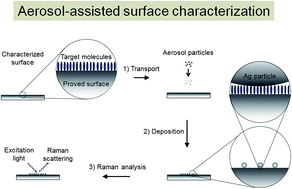A surface coated with organic molecules has been probed by a sub 100 nm resolution particulate sensor by surface-enhanced Raman scattering (SERS) technique. The spatial distribution of those molecules formed on the solid surface was altered by a dip-coating method as a function of a substrate-lifting rate. Isolated silver nanoparticles (∼50 nm) as “antenna” particles were deposited from the gas phase onto the surface by means of an electrostatic-assisted spray. The surface with the particles was analyzed with Raman spectroscopy technique. These analyses provide spatial information on the molecules over the surface, when SERS spectra of the molecules obtained from each measurement point are converted into the position of molecules. The occurrence frequency of SERS is found to be correlated with the two-third power law of the lifting rate which is proportional to a mass concentration of molecules per unit area, whereas the average Raman intensity is independent. A gas-phase route assisted SERS technique offers direct measurement of the molecular patterns on target surfaces.

